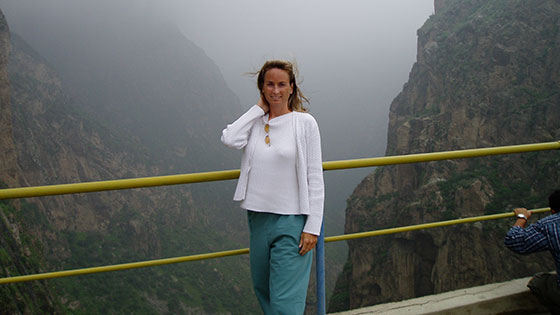
Dr. Andrea Boggild is helping to treat and diagnose parasitic
skin disease in Peru. (Photo: Dr. Andrea Boggild)
Dr. Andrea Boggild, staff physician in the Tropical Disease Unit and Division of Infectious Diseases at UHN has been visiting Lima, the largest city in Peru, as a collaborator with The Leishmaniasis Working group for the past seven years. The Leishmania Clinic in Peru, where Dr. Boggild works once a year for about 10 weeks, sees about 40 new cases of cutaneous leishmaniasis (CL) per month – a parasitic skin disease transmitted by sand fly bites. Some patients are also diagnosed with mucosal leishmaniasis (ML), a more severe and rare form of CL that causes facial disfigurement.
Celebrating World Humanitarian Day
August 19 is World Humanitarian Day – a global celebration of 'people helping people' – an opportunity to recognize those who face adversity to help others.
This year, UHN is featuring Dr. Andrea Boggild, a physician achieving global impact by helping to develop a non-invasive diagnostic technique for CL. This tropical skin disease is most commonly found in: Central and South America, the Mediterranean basin, and the Middle East.
Cutaneous leishmaniasis is marked by sores on the face, arms and legs that often look like volcanoes -- with a central pit and a raised edge. These sores can be painful or painless to those affected and may be covered by scabs.
The World Health Organization (WHO) estimates there are about 1.5 million new cases worldwide diagnosed each year and that 350 million people are at risk.
"This is one of the most neglected tropical diseases in the world," said Dr. Boggild.
In developing countries such as Peru, where occupational health infrastructure does not exist, diagnosing and treating CL can be dangerous for both health care workers and patients. Dr. Boggild explains that resources are limited and diagnosing CL is extremely invasive for patients.
Diagnosing CL in the past: painful for patients
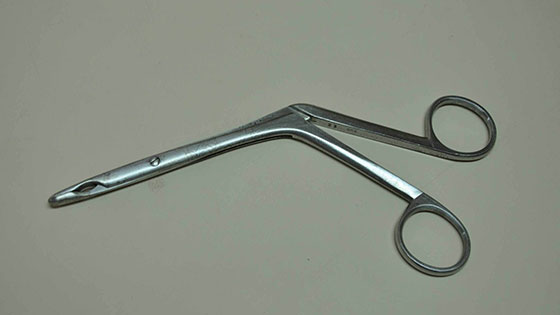
Nasal forceps are used to obtain biopsy samples from patients
for diagnosis of ML. (Photo: Dr. Andrea Boggild)
The 'smear' approach: Invasive tools such as needles and scalpels are used directly on the patient's lesion to pick-up tissue fluid samples and smear onto a slide for closer inspection under a microscope. This method takes about 20 minutes and is only 30-50 percent accurate in identifying CL.
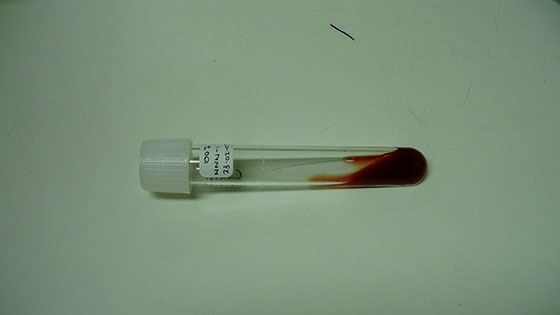
A culture tube is used to grow the parasite from the
patient's sore. (Photo: Dr. Andrea Boggild)
The 'culture' approach: The health professional must use an invasive tool such as a needle to extract the infected cells and place them into a culture (small tube). It can take up to one month for the parasite to grow in the culture. Like the smear approach, this method is also 30-50 percent accurate in identifying disease.
In an under-resourced setting, like many parts of Peru where anesthesia is not readily available, this can be a very painful process for patients. The patient's lesion is traumatized when the health professional uses invasive tools on the affected areas. Both diagnostic processes still underestimate the disease by 50-70 percent.
Turning the tables on 'invasive' CL diagnosis
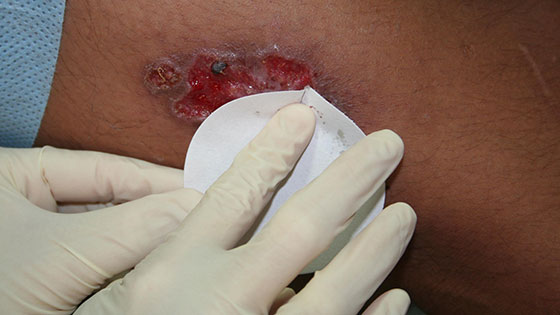
Dr. Boggild pioneers non-invasive technique for collecting
tissue samples: filter paper. (Photo: Dr. Andrea Boggild)
In 2009, Dr. Boggild led The Leishmaniasis Working Group in one of its first studies of non-invasive diagnostic techniques – filter papers. It's absorbent, so when you press it on the lesion, tissue fluid, which contains the parasite, is wicked onto the paper.
"We were able to amplify the parasite DNA without causing pain to the patient," said Dr. Boggild. "But this still required the healthcare worker to come into contact with the patient's ulcer – I wanted to find a way to eliminate that contact completely."
A new frontier: painless for patients
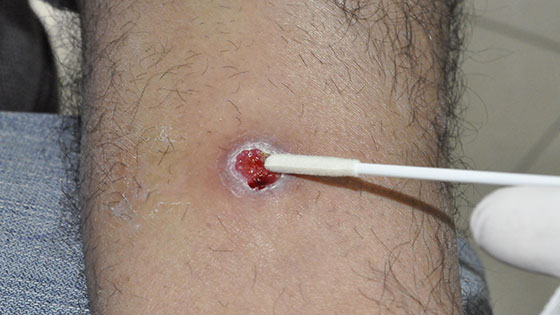
Healthcare workers in Peru are now using Dr. Boggild's non-invasive approach to
collect tissue fluid samples using a soft roll brush. (Photo: Dr. Andrea Boggild.)
One year later, Dr. Boggild did just that. By using a small roll brush to gently pick-up cells, patients feel virtually nothing when they are diagnosed, and the health professional no longer comes into contact with the affected area. Once the cells are picked-up on the small brush, the parasite DNA can be amplified in a lab using polymerase chain reaction, a molecular diagnostic approach.
"In contrast to invasive diagnostic techniques, this approach takes a few hours and is more than 95 per cent accurate in identifying disease," said Dr. Boggild.
A major benefit is that patients can begin therapy immediately instead of having to travel for days from the jungle or mountains to receive diagnosis and treatment.
Dr. Boggild and team on the road
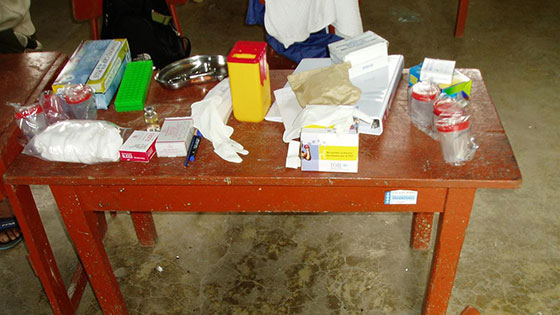
Dr. Boggild and her team in Peru prepare field supplies to visit affected
patients in remote endemic areas. (Photo: Dr. Andrea Boggild)
Dr. Boggild and her team are currently funded by the Belgian Directorate General to enroll patients living in remote endemic areas in Peru and Bolivia in a study that offers mobile support – where healthcare workers travel to where patients live.
Cutaneous forms of leishmaniasis are primarily treated with an intravenous injection of a toxic drug called pentavalent antimony over a 20-day period; accurate diagnosis is important to minimize over-treatment with a toxic therapy.
Dr. Boggild sees the next steps of this project as expanding the work on assessing the pathogenesis of the parasite – understanding how the parasite behaves in the lesion over time and how it reacts to different drug and therapeutic treatments.
Other organizations that have supported Dr. Boggild's leishmaniasis work include: The Ontario Association of Medical Laboratories; The Royal Society of Tropical Medicine and Hygiene; The International Society of Infectious Diseases; The American Society of Tropical Medicine and Hygiene and Public Health Ontario Laboratories.
